25 Francs – A Case Study
As collectors we sometimes come across banknotes that are fascinating or captivating and we would like to add them to our collections but are unable to for years to come (for a variety of reasons). One such banknote for me was the 25 Francs note. The striking singular image without much else to clutter the front of the note as well as the pastel colours used and the image on the back (evoking a sort of arrival to tropical serenity!) was all very intriguing to me. Being a collector of banknotes that interest me, I decided I would like to add this to my collection someday. Many years later when my collection was at a point where I could add one of these notes to it, I found that the same banknote was issued by several countries! While this is not surprising (because it is the case with many notes issued by the monetary federations like the West African States, East Caribbean States, Central African States, French Pacific Territories and many more), it left me with the dilemma of trying to decide which of the 4 countries I should get the note from to add to my collection? It was a difficult choice to make and, as we all tend to do with our obsession with collecting, eventually, I ended up getting one from all four countries of course! Below are my 4 notes:
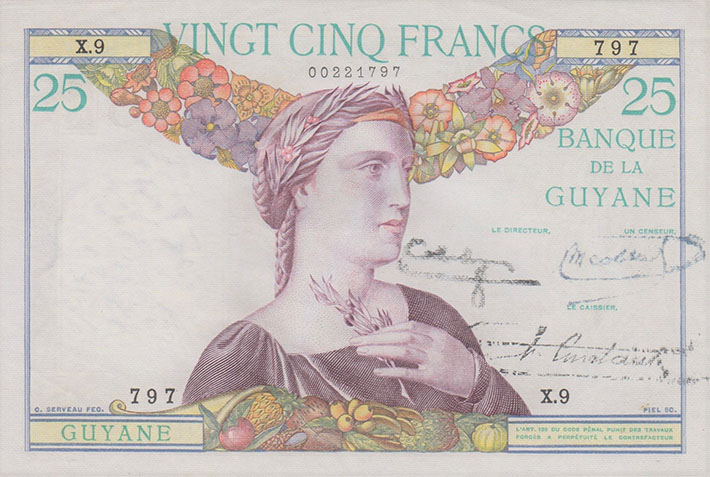



A little background to start with….
At its peak in 1929, France held one of the world’s largest empires during the early 20th century, controlling 12,898,000 sq kms (4,980,000 square miles) - roughly or 8.7% of the Earth’s land area. A full 72 countries were part of France at one time or another.
Since 1929, the size of the French empire has shrunk dramatically. But like other European colonial powers, the French empire never disappeared entirely. Today, you can find the vestiges of the French Empire in islands and territories located around the world. Technically speaking, all of the overseas parts of France are considered an integral part of France. All people who live in overseas France can vote in French elections and have representation in the French parliament. So, France doesn’t have territories in the same way as other countries. It is just a single country, which happens to be scattered all over the world. The non-European parts of France are collectively called the Départements et Territoires D’outre-mer or, the Departments and Territories Overseas.
France is divided into 18 regions, which are fundamentally similar to what’s referred to as states or provinces in other countries. Of those total regions, 13 are located in Europe (12 in mainland France and one in Corsica). These are collectively referred to as Metropolitan France. The other overseas regions are:
- Guadeloupe (Caribbean)
- Martinique (Caribbean)
- French Guiana (South America)
- Réunion (Indian Ocean)
- Mayotte (Indian Ocean)
- Saint Barthélemy (Caribbean)
- Saint Martin (Caribbean)
- Saint Pierre et Miquelon (Gulf of St Lawrence, Canada)
Out of these, the 25 Franc banknote has been used by only the first 4 regions.
French Guiana
French Guiana is the only part of overseas France that is not an island. The region borders Brazil and Suriname, which makes for a great trick trivia question when asked: “What countries border France?” Since French Guiana is actually considered a part of France, Brazil and Suriname really do border France!
French Guiana is one of the least densely populated places on Earth having a density of only two people per square km. Only Mongolia and Greenland have lower population densities. This part of Overseas France is best known as the launch location for the European Space Agency because it is the closest part of the EU to the Equator.
This 25 Franc banknote was first issued in 1933.

On the front at the top features a vignette of a multi coloured flower wreath. In the middle, a bust of a woman, symbolic of the Metropolis holding a branch of laurel. At the bottom of the note is a cornucopia overflowing with exotic fruit including apple, pineapple, coconut, bananas and cherimoyas, symbolising abundance. To the right of the cornucopia is a summary of Article 139 of the French Penal code.
All the text ie. “VINGT CINQ FRANCS” at the top, “BANQUE DE LA GUYANE” on the right side of the banknote, the Penal code at the bottom right, “GUYANE” at the bottom left, the values “25” on the left and right side, as well as the role of the signators “LE DIRECTEUR”, “UN CENSEUR” and “LE CAISSIER” are printed in a pale blue/green colour. There are 3 signatures in black using engraved dies to overprint on the note. Additionally, above “GUYANE” at the bottom left is printed “C. SERVEAU FEC” and above the penal code “PIEL SC” in blue. Above the woman’s head is the control number (00221797) for the note while the series letter and number (X.9) is printed at the top left and bottom right and the order/note number (797) on the top right and bottom left of the note, all in black. We shall look at all these specifics in more detail later in this article.

The back shows a simple image of a lush tropical forest featuring palm, banana and other jungle trees and plants. The perspective is of someone looking out to sea where there is a ship anchored in a bay with some hilly landscape in the background. To the right is a plaque like blank space within which the watermark is placed with “25” printed in a brown colour. At the bottom is “BANQUE DE LA GUYANE” also printed in brown. In the margin at the bottom on the left is printed “CL SERVEAU DEL” and on the right “HOURRIEZ SC” in blue.

Signatures: Lamer/Briais/Quintrie
Series Z.2 – N.3
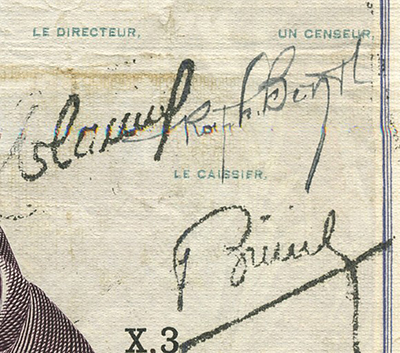
Signatures: Lamer/Briais/Bogat
Series X.3 – Z.3
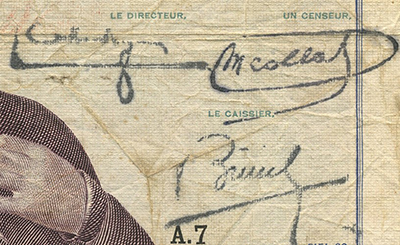
Signatures: Halleguen/Briais/Collat
Series A.7 – E.7
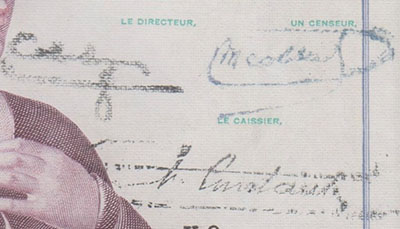
Signatures: Halleguen/Constantin/Collat
Series K.7 – C.10
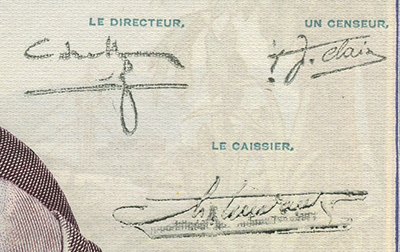
Signatures: Halleguen/Constantin/St. Clair
Series M.10 – K.14
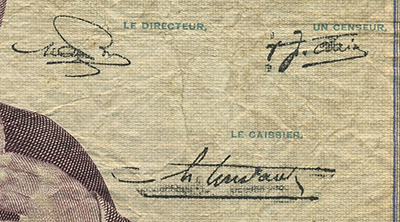
Signatures: Buy/Constantin/St. Clair
Series Z.16 – F.20
This note was demonetized in 1959.
Guadeloupe
Guadeloupe is the most populated European territory in the Americas, with a population of just over 400,000.
It’s located in the Lesser Antilles between the British Territory of Montserrat and the nation of Dominica. The region consists of five islands, Basse-Terre and Grande-Terre, the largest and main islands, and the smaller islands of La Désirade, Les Saintes, and Marie-Galante. The islands of Saint-Martin and Saint-Barthélemy were formerly part of the region of Guadeloupe but were separated and became overseas collectivities in 2003.
This 25 Franc banknote was first issued in 1934

As is obvious the design is the same as the French Guiana note except for all the text that is printed in red. For some reason the value “25” on the left side only is printed in blue.
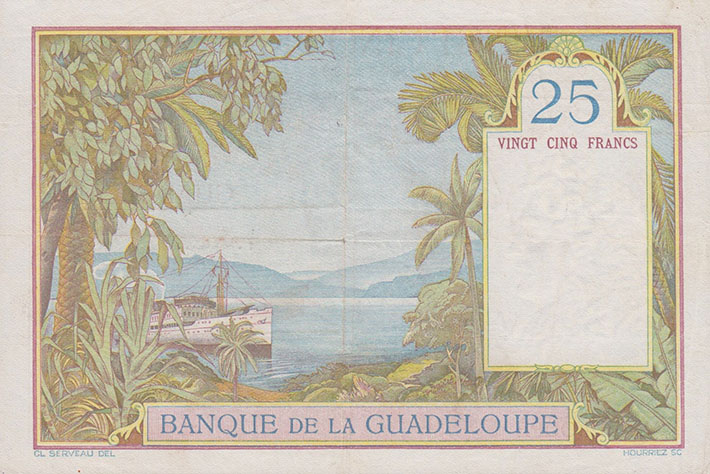
Again, on the back the printing colour of “BANQUE DE LA GUADELOUPE” has been changed to blue as has the value “25”. Also, below the 25 “VINGT CINQ FRANCS” has been added and printed in brown which is not the case for any of the other country prints.

Signatures: Marconnet/Gascon/Picard
Series B.1 – R.25
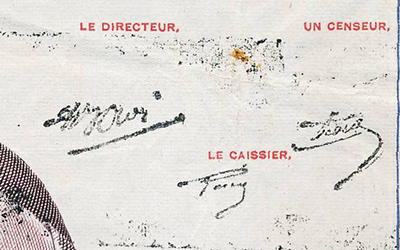
Signatures: Boudin/Gascon/Picard
Series J.33 – Y.39

This note was demonetized in 1959
Martinique
Martinique is located only 70 miles (115 km) south of Guadeloupe. It’s located between the islands of Dominica and Saint Lucia. With 385,551 people, Martinique has a slightly smaller population than Guadeloupe and a slightly smaller area.
This 25 Franc banknote was first issued in 1930.

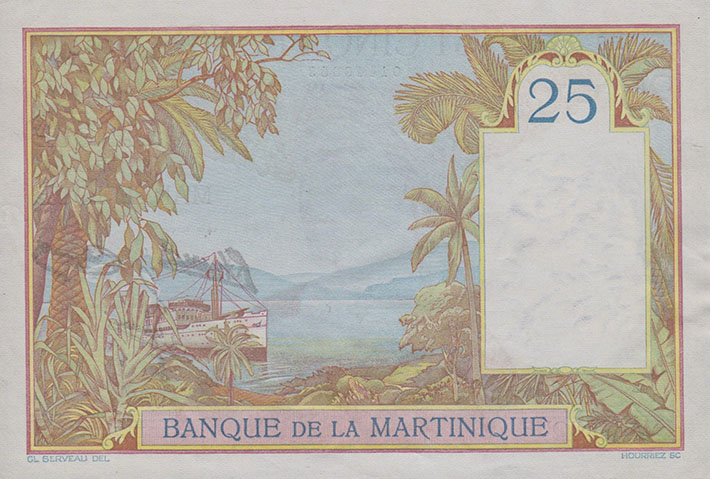

Signatures: Didellot/Hing/Bellonnie
Series L.5 – L.11
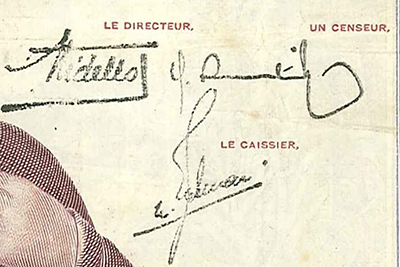
Signatures: Didellot/Rosemain/Berte
Series U.21 – Q.24

Signatures: Didellot/Rosemain/Calvy
Series Q.28 – M.44
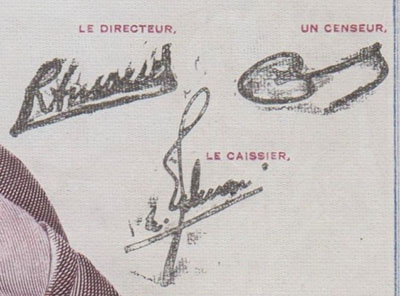
Signatures: Arnaud/Rosemain/Calvy
Series S.41 – Y.64
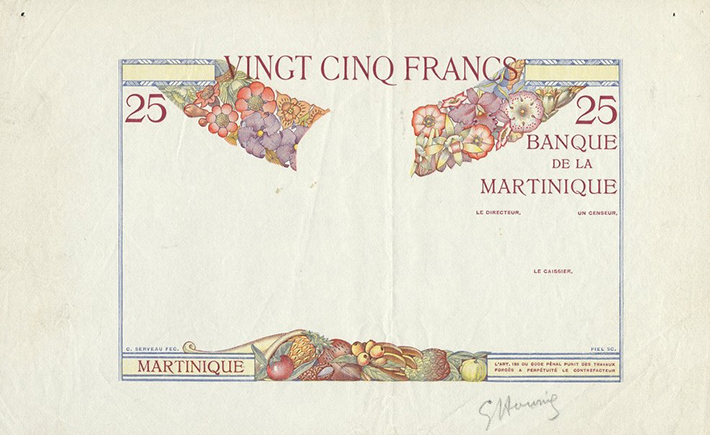
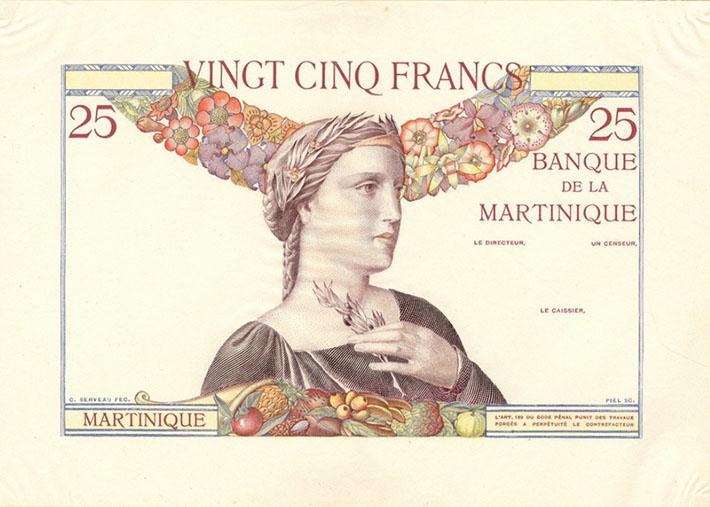

Réunion
Réunion is the other overseas region of France, and the largest overseas region in terms of population, with over 850,000 inhabitants. A single island, it’s located 680 km (420 miles) off the east coast of Madagascar and is approximately 100 miles from the nation of Mauritius.
The population is primarily creole (mixed) with ancestries coming from Madagascar, Europe, India, and China. Unlike Mayotte, the population is mostly Catholic, with small numbers of Hindus and Muslims. Réunion is an outermost region of the European Union and, as an overseas department of France, part of the eurozone!
This 25 Franc banknote was first issued in 1930.



Signatures: Poulet/Masseux/Vally
Series L.3 – J.17

Signatures: Poulet/Ninon/Chatel
Series T.17 – A.24
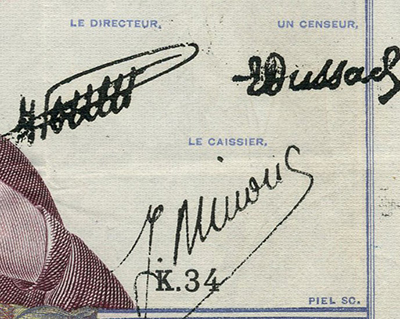
Signatures: Poulet/Ninon/Dussac
Series K.25 – K.34

Signatures: Rabot/Ninon/Dussac
Series G.36 – L.52
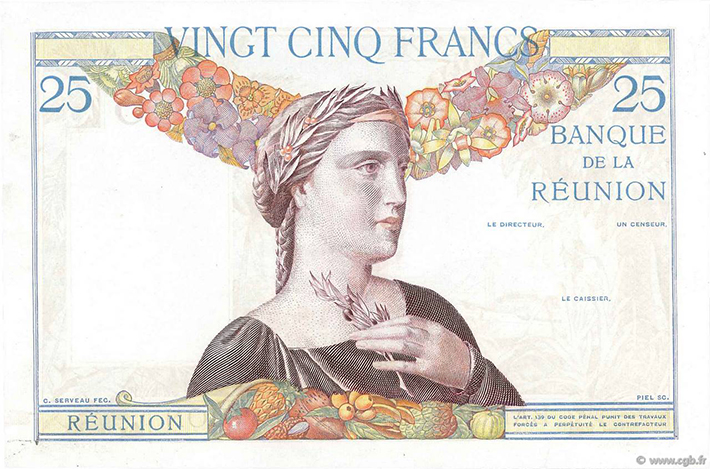

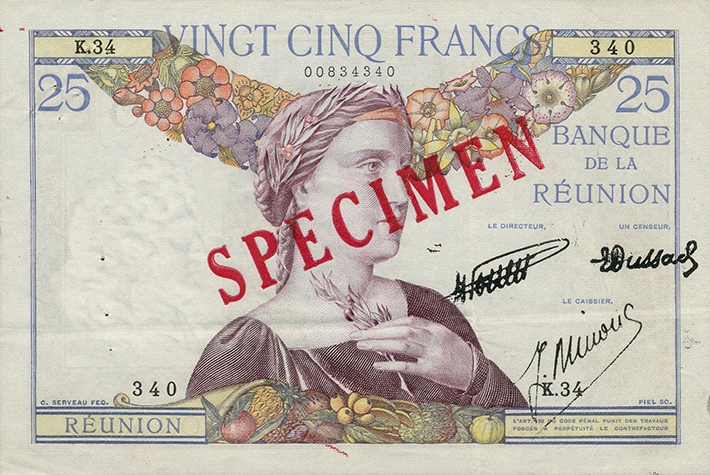

A point of interest about comparative value of the note during its time in circulation. At the Banque de la Reunion in the 1920’s the annual salary of a messenger was 900 Fr, a typist made 2,200 Fr while a secretary earned around 4,400 Fr a year!
This note surprisingly stayed in circulation till 1978!
Now that we have seen the differences between the notes, let us look in more detail at the commonality between them.
a. The watermark:

A profile bust of Jean-Baptiste Colbert. He was a French politician in the 1700’s who became the Minister of Finance in 1661 and served until his death in 1683 during the reign of King Louis XIV.
b. The summary penal code:

“L’ART. 139 DU CODE PÉNAL PUNIT DES TRAVAUX FORCÈS A PERPÉTUITÉ LE CONTREFACTEUR” which means “as per article 139 of the penal code, counterfeiters will be punished by hard labour for perpetuity”!
c. The subtext in different areas on the notes:
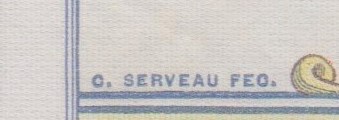
FEC: (Latin: fecit; French: a fait), "he made it" - a broader term used when one person has the role of both INV and DEL –
INV: (Latin: invenit; French: a inventé) the original artist
DEL: (Latin: delineavit; French: a dessiné), producer of the definitive sketch of the design
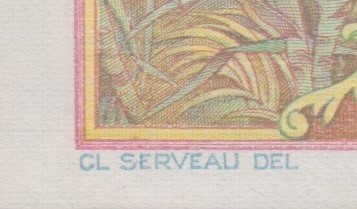
SC: (Latin: sculpsit; French: a sculpté), engraver of the plate (or other medium for printing) –


d. The banknote numbering system:
Taking the following example to illustrate the principle which is valid for banknotes from all the 4 countries

Three numbers visible:
- the control number – 01440383 (serial number unique to this note indicative of its sequence in the printing process)
- the letter and series number – Q.58 (25 letters used - ‘I’ is not used and ‘W’ is used after ‘Z’. Each series has a group of 1000 notes)
- the order/note number – 383 (the number of the note within the series)
So, it’s a simple calculation to get the control number from the combination of the other numbers listed. In the above note, prior to the 58 (in Q.58) there are 57 series (25 for each letter) and 1000 notes per series so 57x25x1000 = 1425000. There are also 15 series prior to Q (A-P with I not included in the count) 15x1000 = 15000. This is the 383rd note printed in this series, so we get a control number of 1425000+15000+383 = 1440383.
e. The design artist:
Clément Serveau. Born in Paris on June 29, 1886 he was a painter/designer/engraver and illustrator. He first joined the National School of Decorative Arts where he became a pupil of Raphael COLIN and Luc Olivier MERSON, who made notes for the Banque de France in 1906. Throughout his career as a painter and since 1920 Clément SERVEAU worked not only for the Bank of France but also for the Banks of Lebanon, Syria, Uruguay, Romania, Serbia, Poland, Madagascar. The Antilles, Reunion and Guyana had their banknotes designed by Clément SERVEAU from 1933. He created for the Bank of France until 1958 and passed away on July 8, 1972. There are over 30 French and French colonial banknotes featuring designs by Clément Serveau. Given the number of banknotes circulated with his designs, one could say he is probably the most published artist in the world! I have picked 2 striking banknotes from my collection with his designs to showcase (a more exhaustive list can be found at www.frenchbanknotes.com).
Firstly, the unusual denomination 300 Franc note (P87) from Banque de France,


and secondly, the iconic 5000 Franc note (P103c) also from Banque de France, featuring some symbolic colonial imagery of times past!

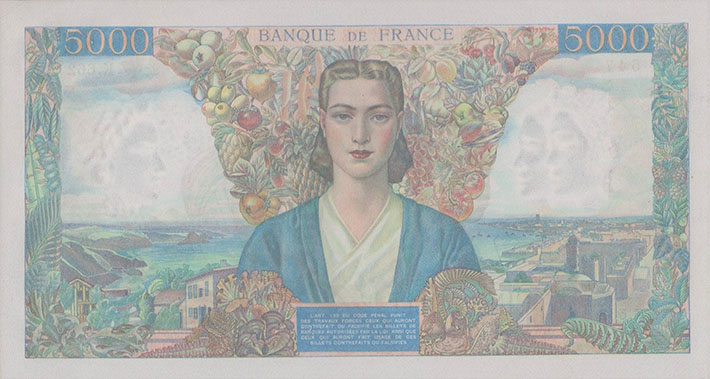
All in all, the 25 Francs is not only a beautifully designed banknote but also a window into the complex, intertwined narrative of geo-politics, history, art and much more. I know all collectors have those special notes that interest them for a variety of reasons and it is these banknotes that draw us further into our hobby.
Happy collecting!
Mark Lazarus IBNS 11483
a320busdriver@gmail.com